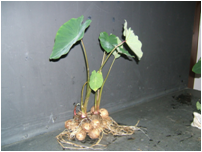SummaryTaro is an important crop to subsistence farmers because of its potential to alleviate food insecurity, and, in KwaZulu-Natal,
South Africa, it is a recently-discovered cash crop by the mainstream food market. Different taro landraces have different agronomic,
A field trial was carried out at two locations and designed as a factorial split-plot field experiment to compare the effects of planting date and rate of application of organic fertiliser on plant growth, corm yield, corm crisping quality and mineral content of three taro landraces. Taro is grown at different subsistence farming locations in South Africa. Comparison of performances at the two locations was of interest to the researchers to assist with their advice to farmers and extension officers. In a second study corms of the three landraces, harvested from one of the locations and the first two planting dates, were packaged in three different ways and stored at two different temperatures to assess their quality after storage for four months. A third study was included to study the performance of first generation corms on their emergence and stand establishment. Methods of study design are described for each of these studies and methods of factorial statistical analysis and reporting demonstrated for one of the field trials. |
 nutritional and morphological characteristics. Producers and marketers of taro are interested in knowing which landrace is the best in
terms of yield, storability and food quality. With this aim in mind studies were designed to determine taro growth in relation to yield,
corm crisping quality, mineral content and storability. This case study shows how a strategy for
undertaking this research was developed and describes the different studies undertaken during the research process.
nutritional and morphological characteristics. Producers and marketers of taro are interested in knowing which landrace is the best in
terms of yield, storability and food quality. With this aim in mind studies were designed to determine taro growth in relation to yield,
corm crisping quality, mineral content and storability. This case study shows how a strategy for
undertaking this research was developed and describes the different studies undertaken during the research process.